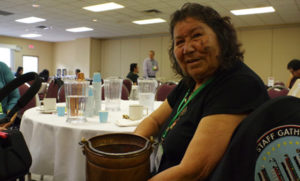Wikwemikong Waterwalker performed water ceremony for Northern Ontario First Nation Environment Conference

By Rick Garrick
THUNDER BAY—A water ceremony by Waterwalker Josephine Mandamin and a presentation on Pays Plat’s Source Water Protection were featured at this year’s Northern Ontario First Nation Environment Conference.
“It is important to honour the water every day,” says Mandamin, a Wikwemikong citizen who lives in Thunder Bay. “Every day when you wake up you honour the water—you put a glass of water and you offer tobacco. And you pray to the water that you are going to be drinking and be using all day. Think about what you are going to be doing with the water all day. When you shower and when you brush your teeth, you are using water, so everything we do is about water. Even this conference is about water. You always have to think about water first.”
Mandamin performed the water ceremony to open the conference, which was held Oct. 4-6 at the Best Western Plus NorWester Hotel and Conference Centre near Thunder Bay.
“We have petitioned to the Creator when we think about our relatives in the far east, the far west, across the oceans where they don’t have any water,” Mandamin says. “Their water has always been a need for them. There is always so much controversy about what is happening in the other [countries]. We want them to have clean water too.”
Mandamin says people around the world are now doing their own water walks.
“We’ve heard from Finland, Switzerland, Japan that they did their own water walks,” Mandamin says. “So its worldwide now. People are doing their waterwalks in the Great Lakes area.”
Debbie King, Pays Plat’s environmental technician, also spoke about the importance of water during the Source Water Protection presentation she delivered with James Salter from Lakehead University, on the second day of the conference.
“We’ve been testing water in our areas and creating a baseline database with the information so if there are changes in the future, we will be able to note them easily,” King says. ”We send these samples in to an accredited lab and we get them tested for quite a range of parameters, [including] alkalinity, conductivity, pH, mercury, total dissolved solids, total suspended solids, phosphates, and nitrates.”
King says the water was tested on Lake Superior, the source of the community’s water, and some of the inland lakes in the area. Although some contaminated lakes were found to the north where a copper and zinc mine operated until the mid-1990s, King says the mining company is monitoring and treating those lakes.
“We did do some testing on the river — we do it about three times a year upstream of where the community sits and right at the mouth of the river before it actually enters Lake Superior,” King says. “Everything has been good so far. We are very fortunate as a First Nation that we are so close to great source water.”
King says the community is currently working on installing water intake zone markers and emergency response phone number signs in case there is an accident on the bridges near the community.
“We have to be very vigilant on what is happening around us,” King says. “The truck driver or another vehicle going by can call that [emergency response] action number and the MTO [Ministry of Transportation of Ontario] or the Spills Action Centre can get there as quick as possible to help prevent that spill from getting further downstream.”
The conference featured about 20 presentations on resource development and land planning as well as nine Operations and Maintenance training sessions. Conference details are available online.


